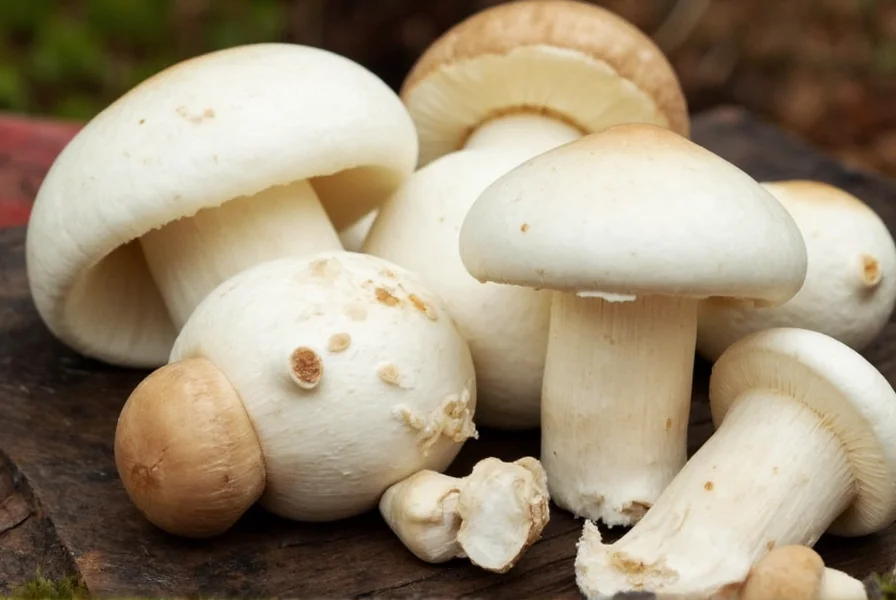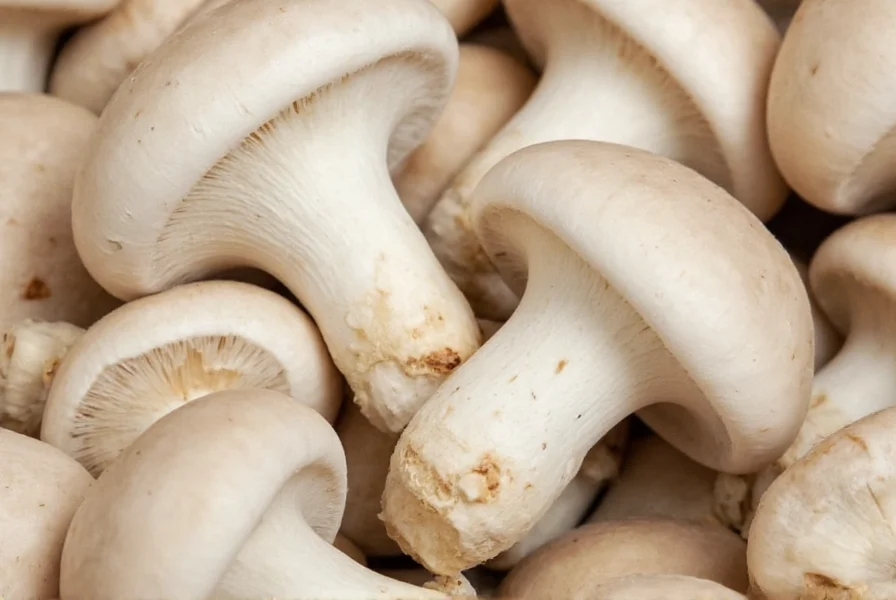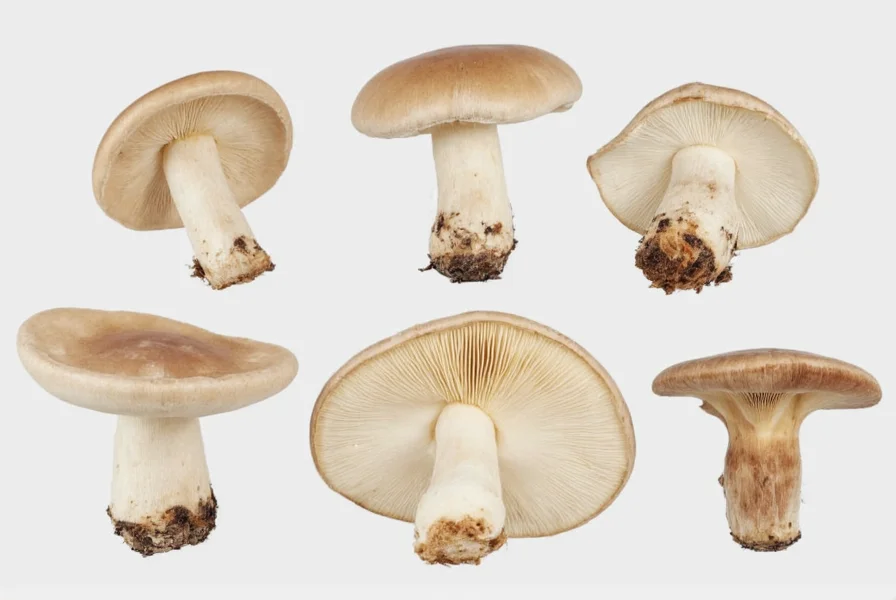When exploring the world of edible fungi, understanding white mushrooms is essential for both culinary enthusiasts and foragers. These versatile organisms represent some of the most commonly consumed mushrooms globally, yet proper identification remains critical for safety.
Common Varieties of White Mushrooms
The term "white mushrooms" typically refers to several stages of Agaricus bisporus development. This species accounts for approximately 90% of mushrooms consumed worldwide. The three primary commercial varieties include:
| Variety | Characteristics | Common Uses |
|---|---|---|
| Button Mushrooms | Immature stage, smooth white cap (1-2 inches), mild flavor | Salads, garnishes, raw consumption |
| Cremini (Baby Bella) | Brownish cap, firmer texture, earthier flavor than button | Sautéing, soups, sauces |
| Portobello | Mature stage, large cap (4-6 inches), robust flavor | Grilling, roasting, meat substitute |
Safety Considerations for White Mushroom Identification
Proper identification of white mushrooms separates safe culinary experiences from potentially dangerous situations. While cultivated varieties pose minimal risk, wild white mushrooms require careful examination. The death cap (Amanita phalloides) and destroying angel (Amanita virosa) both feature white characteristics but contain lethal toxins.
Key identification markers for safe white mushrooms include:
- Brown or pink gills (rather than white)
- A skirt-like ring on the stem
- Presence of a sac at the base (volva) in Amanita species (indicating potential toxicity)
- Spore print color (Agaricus species produce brown spores)
For beginners interested in foraging white mushrooms, consulting with experienced mycologists through local mushroom clubs remains the safest approach. Never consume wild mushrooms without absolute certainty of their identification.

Nutritional Profile and Health Benefits
White mushrooms deliver impressive nutritional value despite their low calorie count. A 100g serving of raw button mushrooms contains:
- 22 calories
- 3.1g protein
- 0.3g fat
- 3.3g carbohydrates
- 1g dietary fiber
- Significant selenium (11% DV), riboflavin (11% DV), and niacin (10% DV)
Research indicates several potential health benefits associated with regular white mushroom consumption. Their selenium content supports antioxidant activity, while ergothioneine provides cellular protection. The natural vitamin D content increases significantly when mushrooms are exposed to sunlight during growth.
Culinary Applications and Preparation Tips
White mushrooms offer remarkable versatility in the kitchen. Understanding proper preparation techniques maximizes both flavor and nutritional retention. When cooking white button mushrooms, avoid overcrowding the pan to prevent steaming and ensure proper browning.
Professional chefs recommend these techniques for enhancing white mushroom flavor:
- Sautéing in butter or olive oil over medium-high heat
- Adding salt only after mushrooms have released their moisture
- Finishing with fresh herbs like thyme or parsley
- Using in combination with onions and garlic for enhanced umami
For preservation, white mushrooms maintain quality when refrigerated in paper bags rather than plastic containers. Freezing requires prior cooking to preserve texture. Drying transforms their flavor profile, concentrating umami compounds for use in stocks and sauces.

Home Cultivation of White Mushrooms
Growing white mushrooms at home has become increasingly accessible through commercially available kits. These typically use sterilized substrate blocks inoculated with Agaricus bisporus mycelium. Successful cultivation requires maintaining specific environmental conditions:
- Temperature: 55-65°F (13-18°C) during fruiting
- Humidity: 85-95% relative humidity
- Light: Indirect light for 6-8 hours daily
- Ventilation: Gentle air exchange without direct drafts
Harvest timing significantly impacts flavor and texture. For button mushrooms, pick when the veil beneath the cap remains intact but the cap begins to separate from the stem. Delaying harvest produces cremini and eventually portobello varieties as the mushrooms mature.
Conclusion
White mushrooms represent one of nature's most accessible and versatile food sources when properly identified and prepared. From the common button mushroom found in grocery stores to carefully foraged wild varieties, understanding their characteristics ensures both safety and culinary satisfaction. Whether incorporating them into daily meals for nutritional benefits or exploring cultivation as a hobby, white mushrooms offer something for everyone interested in expanding their food knowledge.
Are all white mushrooms safe to eat?
No, not all white mushrooms are safe to eat. While cultivated varieties like button mushrooms are safe, several deadly poisonous species including the death cap and destroying angel appear white. Proper identification by an expert is essential before consuming any wild mushroom.
What's the difference between white button mushrooms and cremini mushrooms?
White button mushrooms and cremini mushrooms are actually the same species (Agaricus bisporus) at different maturity stages. Button mushrooms are harvested young with white caps, while cremini (also called baby bella) are slightly mature with light brown caps and a more developed, earthy flavor.
How should I store white mushrooms to maximize freshness?
Store white mushrooms in a paper bag in the refrigerator rather than plastic containers. The paper absorbs excess moisture while allowing proper air circulation. Avoid washing mushrooms until ready to use, as excess moisture accelerates spoilage. Properly stored, they typically remain fresh for 5-7 days.
Can white mushrooms be eaten raw?
Yes, cultivated white button mushrooms can be safely eaten raw. They're commonly used in salads and as garnishes. However, cooking enhances their digestibility and makes certain nutrients more bioavailable. Raw consumption of wild mushrooms is never recommended without absolute certainty of identification.
What nutritional benefits do white mushrooms provide?
White mushrooms offer significant nutritional value including selenium (supports antioxidant activity), B vitamins (particularly riboflavin and niacin), and a modest protein content. They're low in calories and carbohydrates while providing dietary fiber. When exposed to sunlight, they naturally produce vitamin D, making them one of the few non-animal food sources of this essential nutrient.











 浙公网安备
33010002000092号
浙公网安备
33010002000092号 浙B2-20120091-4
浙B2-20120091-4